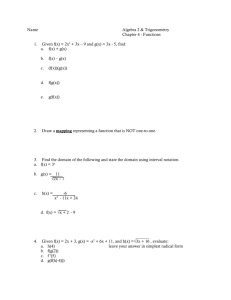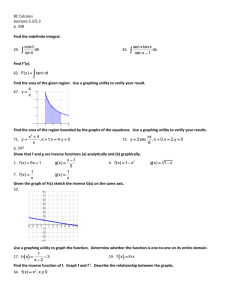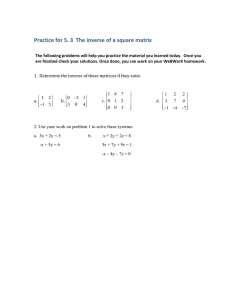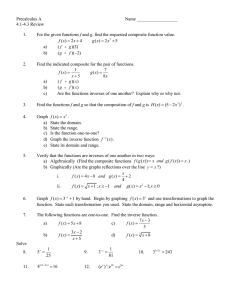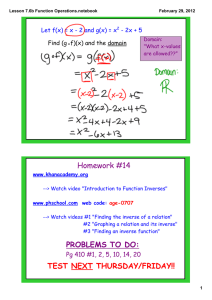Document 17600130
advertisement
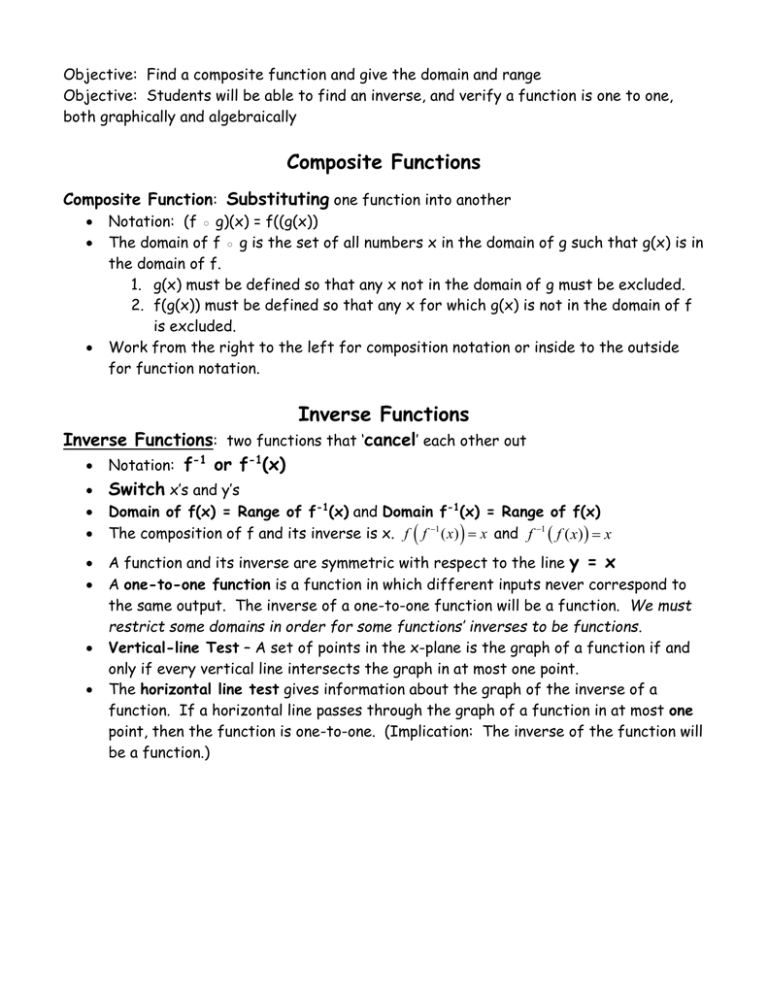
Objective: Find a composite function and give the domain and range
Objective: Students will be able to find an inverse, and verify a function is one to one,
both graphically and algebraically
Composite Functions
Composite Function: Substituting one function into another
Notation: (f ◦ g)(x) = f((g(x))
The domain of f ◦ g is the set of all numbers x in the domain of g such that g(x) is in
the domain of f.
1. g(x) must be defined so that any x not in the domain of g must be excluded.
2. f(g(x)) must be defined so that any x for which g(x) is not in the domain of f
is excluded.
Work from the right to the left for composition notation or inside to the outside
for function notation.
Inverse Functions
Inverse Functions: two functions that ‘cancel’ each other out
Notation: f-1 or f-1(x)
Switch x’s and y’s
Domain of f(x) = Range of f-1(x) and Domain f-1(x) = Range of f(x)
The composition of f and its inverse is x. f f 1 ( x) x and f 1 f ( x) x
A function and its inverse are symmetric with respect to the line y = x
A one-to-one function is a function in which different inputs never correspond to
the same output. The inverse of a one-to-one function will be a function. We must
restrict some domains in order for some functions’ inverses to be functions.
Vertical-line Test – A set of points in the x-plane is the graph of a function if and
only if every vertical line intersects the graph in at most one point.
The horizontal line test gives information about the graph of the inverse of a
function. If a horizontal line passes through the graph of a function in at most one
point, then the function is one-to-one. (Implication: The inverse of the function will
be a function.)
Ex 1 Find the inverse of the functions below. Identify if the functions are one-to-one.
a) {(-2, 5), (-1, 2), (0, 1), (1, 2), (2, 5)}
b) {(-2, -11), (-1, -4), (0, -3), (1, -2), (2, 5)}
Inverse:
Inverse:
One-to-one?
One-to-one?
Ex 2 Analyze the following graphs to determine if the inverses will be functions.
a)
b)
c)
Ex 3 Prove that f(x) = 2x – 5 and g(x) = ½(x + 5) are inverses of each other by showing
that f(g(x)) = x and the g(f(x)) = x.
Show that f(g(x)) = x.
Show that g(f(x)) = x.
Finding the Inverse of a Function:
1. If f is not one-to one, define the domain of f so that f is one-to-one.
2. Switch the variables x and y to define f-1 implicitly.
3. Solve for y if possible to find the explicit form of f-1.
4. Verify the result by showing that f-1(f(x)) = x and that f(f-1(x)) = x.
Ex 4 Find the inverse of the following functions. State the domain and range of the
function and its inverse.
4x 1
b) g ( x) x 2 3
a) f ( x)
x7
f(x) =
f-1(x) =
g(x) =
g-1(x) =
Domain of f:
Domain of f-1:
Domain of g:
Domain of g-1:
Range of f:
Range of f-1:
Range of g:
Range of g-1:
Ex 5 Graph the inverse of the functions in the graphs below.
a)
b)
Notice: The graphs are symmetric with respect to the line _______.
